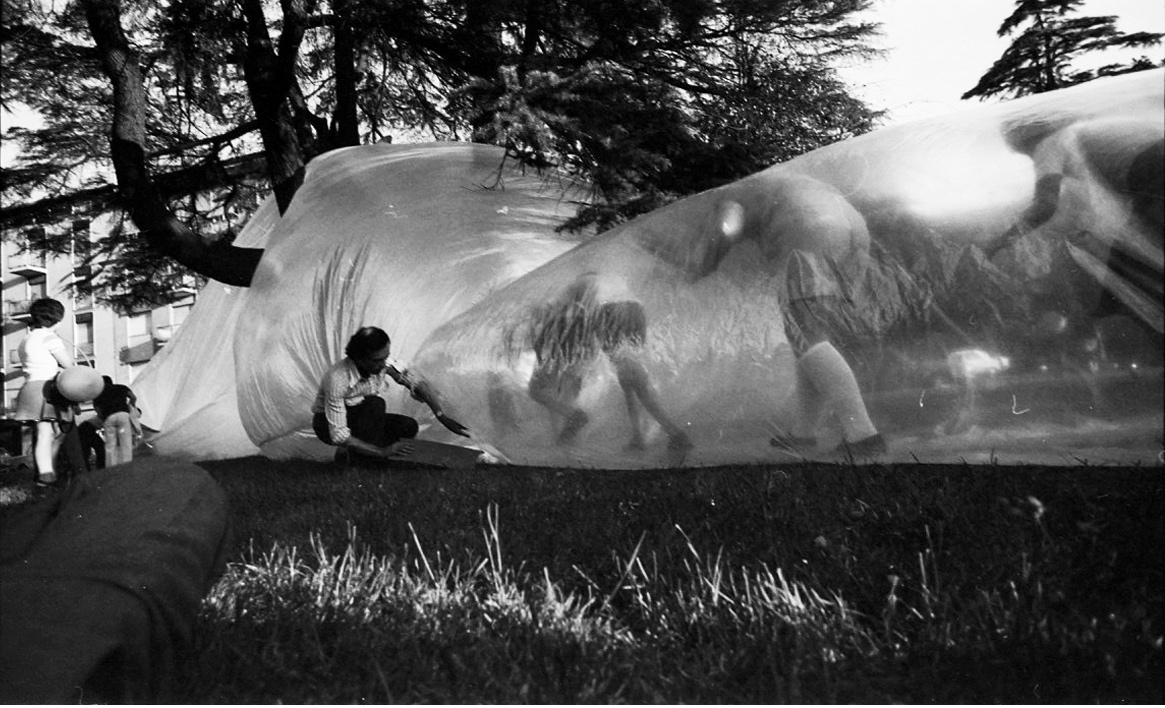Opening, March 8, 6:30 PM
Curated by Marina Pugliese
In collaboration with MUDEC – Museum of Cultures, Milan
The MAN Museum in Nuoro announces the upcoming solo exhibition Blow Up, dedicated to Italian artist Franco Mazzucchelli (Milan, 1939). Curated by Marina Pugliese and developed through a partnership with MUDEC – Museum of Cultures in Milan, the exhibition traces Mazzucchelli’s artistic research from the 1960s to the present, through a selection of works and photographs that highlight the experimental, social, and participatory nature of his practice.
In keeping with MAN’s ongoing research into artists whose work engages with themes of sustainability and community, Blow Up retraces the artist’s path through public and shared space, artistic actions that have reactivated and redefined urban environments through participatory interventions. The exhibition reflects how Mazzucchelli has, over time, invited communities to reclaim neglected spaces through new meanings and collective engagement.
Key works in the show reference his early Abbandoni (Abandonments) from the 1960s and the later series A. TO A. (Art to Abandon), including interventions staged outside the Alfa Romeo factory on Via Traiano in Milan (1971), in the square of the Art High School in Turin (1971), and in Piazza dei Priori in Volterra (1973). These actions are centered around the act of “abandoning” large inflatable PVC structures in public spaces: embodied gestures of openness, interaction, and critical reflection on liberating art from traditional exhibition contexts.
Originally intended for children at a nearby playground, the 1971 Alfa Romeo intervention unexpectedly became a moment of leisure and imagination for factory workers and ultimately even a political tool, when workers used the inflatable structure to block the passage of vehicles. In Volterra, in 1973, during a landmark environmental art exhibition curated by Enrico Crispolti, Mazzucchelli’s inflatables turned into the centerpiece of a collective celebration. In Turin, the installation of a giant inflatable arch in an urban setting led to new interpretations of both landscape and social fabric.
One historically significant work, presented for the first time in a public Italian institution, is Caduta di Pressione(Pressure Drop), first shown in 1974 at Galleria Diagramma in Milan. The piece involved measuring oxygen consumption in a room using a hand-held vacuum gauge, depending on the number of guests present. The result was a kind of cartography of breath and vacuum, recorded like a scientific experiment in file cards that still preserve pressure readings and the names of visitors, including artists and critics such as Agnetti, Fabro, Nigro, La Pietra, as well as Gillo Dorfles, Urs Lüthi, and Tommaso Trini.
The exhibition also features two monumental inflatable PVC sculptures: a 26-meter-long Squid (Totano) and a 12-meter-high Cone, exemplifying Mazzucchelli’s concept of sculpture as an expanded, temporary form. These synthetic, large-scale structures take on playful, non-functional forms that alter architectural space and provoke spontaneous visitor interaction. Over the years, Mazzucchelli has meticulously documented these public responses as a form of behavioral analysis in the presence of these foreign and unexpected insertions.
A site-specific installation from the Riappropriazioni (Reappropriations) cycle—first developed in the 1970s at locations such as Parco Sempione and La Triennale in Milan—occupies and engulfs one of the museum’s rooms. Constructed from plastic film membranes, the work cancels spatial boundaries and proposes new modes of aesthetic experience. Viewers are invited to physically enter the structure, immersed in its metaphysical suspension, which clings to ceilings and floors like a living membrane. Enclosed within it is an early sculpture by Mazzucchelli, created during his time studying under Marino Marini at the Brera Academy. The work embodies the ongoing dialogue between the artist and the collective dimension of his practice: art as a space for encounter, a process open to symbolic reappropriation of space by its inhabitants.
Through the interplay of monumentality and lightness, suspension and adhesion, Mazzucchelli’s work embraces materials once considered experimental—such as plastic—while offering contemporary ecological reflections. The exhibition title, Blow Up, nods to the explosive imagery of Antonioni’s iconic film, capturing the essence of an artist who has redefined the language of contemporary sculpture, moving art out of the museum and into daily life in a constant exploration of aesthetics, society, and participation.
Franco Mazzucchelli
Born in 1939 in Milan, where he currently lives and works. Mazzucchelli is renowned for his pioneering experimentation with synthetic materials beginning in the 1960s, and for his large-scale environmental installations capable of disrupting the everyday conventions of local communities. His practice—close to the ideal of total participation—investigates social dynamics, with works that become temporary parts of the urban landscape. The public is naturally drawn to touch, move, play with, and even take them away.
Since the early 2000s, his research has taken on a more aestheticized direction with the Bieca Decorazione(Dull Decoration) series: an ironic term the artist uses to describe painting as a purely aesthetic pleasure, while critiquing its links to market logic. Mazzucchelli’s environmental installations have been presented in numerous locations in Italy and abroad, including the Alfa Romeo Factory, Milan; Piazza San Fedele, Milan; Brera Academy of Fine Arts, Milan; Castello Sforzesco, Milan; Piazza dei Priori, Volterra; Lake Como; Munich; the Camargue.
His works have featured in major international exhibitions, including the 60th Venice Biennale (2024); 13th and 11th Quadriennale of Rome (1999 and 1986); the 37th Venice Biennale (1976); the 15th Milan Triennale (1973); and in prominent international institutions such as MAPS – Museum of Art in Public Spaces, Køge (2025); Museo Madre, Naples (2024); MACRO, Rome (2021); Centre Pompidou-Metz (2021); Cité de l’Architecture, Paris (2021); ArtScience Museum, Singapore (2020); Konsthall Lund (2020); Kunsthalle Wien (2019); ZKM – Center for Art and Media, Karlsruhe (2019); nGbK, Berlin (2018); and Museo del Novecento, Milan (2018), among others. In 2022, Mazzucchelli received the Alfredo d’Andrade Lifetime Achievement Award. He served as Acting Director of Brera 2 and Professor of Sculpture Techniques at the Brera Academy of Fine Arts in Milan.

